
The River Clyde is a river that flows into the Firth of Clyde, in the west of Scotland. It is the ninth-longest river in the United Kingdom, and the third longest in Scotland after the River Tay and the River Spey. It runs through the city of Glasgow. The River Clyde estuary has an upper tidal limit located at the tidal weir next to Glasgow Green.
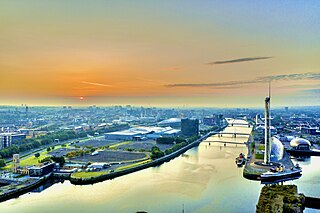
Glasgow is the most populous city in Scotland, located on the banks of the River Clyde in west central Scotland. The city is the third-most populous city in the United Kingdom and the 27th-most populous city in Europe. In 2022, it had an estimated population as a defined locality of 632,350 and anchored an urban settlement of 1,028,220. The economy of Glasgow is the largest of any city or region in Scotland's economy, and the city's economic strength is reflected in its membership of the Core Cities Group.
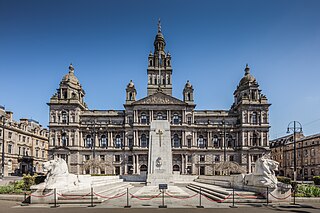
Glasgow City Council is the local government authority for Glasgow City council area, Scotland. In its modern form it was created in 1996. Glasgow was formerly governed by a corporation, also known as the town council, from the granting of its first burgh charter in the 1170s until 1975. From 1975 until 1996 the city was governed by City of Glasgow District Council, a lower-tier authority within the Strathclyde region.

Partick is an area of Glasgow on the north bank of the River Clyde, just across from Govan. To the west lies Whiteinch, to the east Yorkhill and Kelvingrove Park, and to the north Broomhill, Hyndland, Dowanhill, Hillhead, areas which form part of the West End of Glasgow. Partick was a Police burgh from 1852 until 1912 when it was incorporated into the city. Partick is the area of the city most connected with the Highlands, and several Gaelic agencies, such as the Gaelic Books Council are located in the area. Some ATMs in the area display Gaelic.
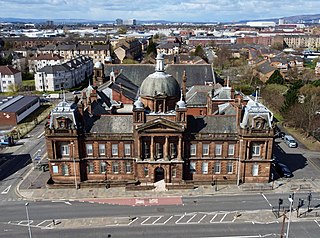
Govan is a district, parish, and former burgh now part of southwest Glasgow, Scotland. It is situated 2+1⁄2 miles west of Glasgow city centre, on the south bank of the River Clyde, opposite the mouth of the River Kelvin and the district of Partick. Historically it was part of the County of Lanark.
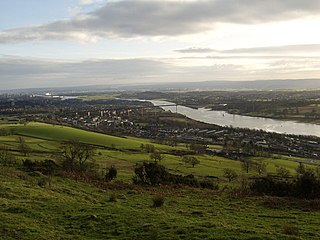
Clydebank is a town in West Dunbartonshire, Scotland. Situated on the north bank of the River Clyde, it borders the village of Old Kilpatrick to the west, and the Yoker and Drumchapel areas of the adjacent City of Glasgow immediately to the east. Depending on the definition of the town's boundaries, the suburban areas of Duntocher, Faifley and Hardgate either surround Clydebank to the north, or are its northern outskirts, with the Kilpatrick Hills beyond.

Scotstoun is an area of Glasgow, Scotland, west of Glasgow City Centre. It is bounded by Garscadden and Yoker to the west, Victoria Park, Jordanhill and Whiteinch to the east, Jordanhill to the north and the River Clyde to the south. At the heart of Scotstoun lies Scotstounhill, an enclave of late Victorian and post-war housing centred on Scotstounhill railway station. Scotstoun is home to BAE Systems Surface Ships, and to the Glasgow Warriors rugby team.

This article is intended to show a timeline of the history of Glasgow, Scotland, up to the present day.

This article deals with the history of the city of Glasgow, Scotland.
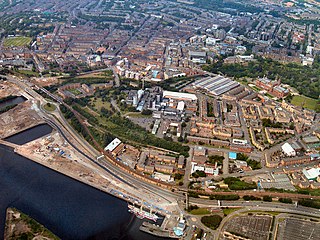
Yorkhill is an area in the city of Glasgow, Scotland. It is situated north of the River Clyde in the West End of the city. It is known for its famous hospitals and remains the location of the West Glasgow Ambulatory Care Hospital.

Whiteinch is an area in the city of Glasgow, Scotland. It is situated directly north of the River Clyde, between the Partick and Scotstoun areas of the city. Whiteinch was at one stage part of the burgh of Partick, until that burgh's absorption into the expanding city of Glasgow in 1912, and part of the Parish of Govan.
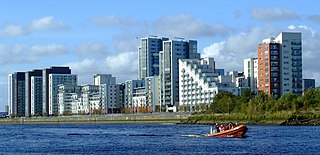
Glasgow Harbour in the following paragraphs is about a private sector urban regeneration scheme at Partick in the West End of the city of Glasgow, Scotland. It is not the history and development of the wider and internationally famous Glasgow Harbour from Glasgow Green to Clydebank which developed from the early 1800s and witnessed the birth and growth of modern shipbuilding and shipping.

Renfrewshire or the County of Renfrew is a historic county, registration county and lieutenancy area in the west central Lowlands of Scotland. The lieutenancy area covers the three modern council areas of Inverclyde, Renfrewshire and East Renfrewshire, and this area is occasionally termed Greater Renfrewshire to distinguish it from the modern council area called Renfrewshire. The historic county additionally included territory on the south-western edge of Glasgow which was gradually transferred to the administrative area of the city as it grew.
John Macgregor (1802–1858) was a Scottish shipbuilder.

The Riverside Museum is a museum in the Partick area of Glasgow, Scotland, housed in a building designed by Zaha Hadid Architects, with its River Clyde frontage at the new Pointhouse Quay. It forms part of the Glasgow Harbour regeneration project. The building opened in June 2011, winning the 2013 European Museum of the Year Award. It houses many exhibits of national and international importance. The Govan–Partick Bridge, which will provide a pedestrian and cycle path link from the museum across the Clyde to Govan, is set to be completed in 2024.
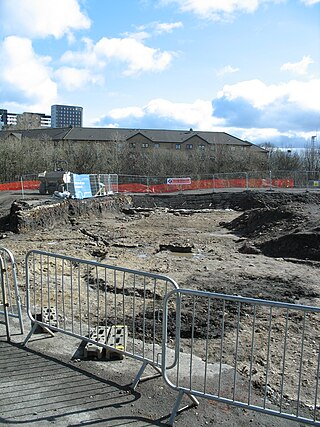
Partick Castle was located in Partick, now a Western suburb of Glasgow. It was built in 1611 for the Glasgow benefactor George Hutcheson and situated on the west bank of the River Kelvin.

The city of Glasgow, located in Scotland, UK, is represented in both the Westminster Parliament in London, and the Scottish Parliament in Holyrood, Edinburgh. At Westminster, it is represented by seven Members of Parliament (MPs), all elected to represent individual constituencies at least once every five years, using the first-past-the-post system of voting. In Holyrood, Glasgow is represented by sixteen MSPs, nine of whom are elected to represent individual constituencies once every five years using first-past-the-post, and seven of whom are elected as additional members, through proportional representation.
The politics of Glasgow, Scotland's largest city by population, are expressed in the deliberations and decisions of Glasgow City Council, in elections to the council, the Scottish Parliament and the UK Parliament.

Rachel Molly Hamilton, also known as Big Rachel, (1829–1899) was an Irish-born woman who was a special constable during the Partick Riots in Glasgow in 1875.

Partick Police Station, previously known as Partick Police Court and also as the Old Burgh Hall, is a former municipal and judicial building on Anderson Street in Partick, Scotland. The building, which was previously the meeting place of the burgh council and now serves as the offices of the Centre for Sensory Impaired People, is a Category B listed building.


















